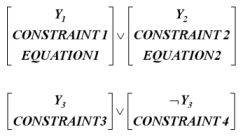

|
disjunction_name IS IF term_condition THEN constraint_name_1; … constraint_name_i ; … constraint_name_n ; [ELSE] | [ELSIF term_condition THEN] constraint_name_n+1; … constraint_name_r; … constraint_name_z; ENDIF; |
|
$ONECHO > "%lm.info%" Disjunction D1, D2; D1 IS IF Y('1') THEN CONSTRAINT1; EQUATION1; ELSIF Y('2') THEN CONSTRAINT2; EQUATION2; ENDIF;< D2 IS IF Y('3') THEN CONSTRAINT3; ELSE CONSTRAINT4; ENDIF; $OFFECHO |

|
$ONECHO > "%lm.info%" Disjunction D(j); D(j) IS IF Y(j) THEN CONSTR1(j); CONSTR2(i,j); ELSE CONSTR3(j); CONSTR4(j,k); ENDIF; $OFFECHO |
|
$ONECHO > "%lm.info%" Disjunction D(j); D('1') IS IF Y('1') THEN CONSTR1('1'); CONSTR2('1','1'); CONSTR2('2','1'); CONSTR2('3','1'); ELSE CONSTR3('1'); CONSTR4('1','a'); CONSTR4('1','b'); ENDIF; D('2') IS IF Y('2') THEN CONSTR1('2'); CONSTR2('1','2'); CONSTR2('2','2'); CONSTR2('3','2'); ELSE CONSTR3('2'); CONSTR4('2','a'); CONSTR4('2','b'); ENDIF; $OFFECHO |
Relational operators:
|
Sets operators:
|
|||||||||||||||||
| Logic operators: and, or. | Using subsets | |||||||||||||||||